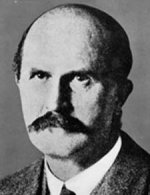|
 William Henry Bragg, who won the Nobel Prize in physics, was born in Westward, Wigton, Cumberland on July 2, 1862. He was the son of Robert John Bragg, who was a farmer and merchant navy officer and Mary Wood, the daughter of a clergyman. Mary died in 1869 and Bragg was thereafter raised by his uncle in Market Harborough, Leicestershire. William Henry Bragg, who won the Nobel Prize in physics, was born in Westward, Wigton, Cumberland on July 2, 1862. He was the son of Robert John Bragg, who was a farmer and merchant navy officer and Mary Wood, the daughter of a clergyman. Mary died in 1869 and Bragg was thereafter raised by his uncle in Market Harborough, Leicestershire.
Bragg attended Market Harborough Grammar School and then King William’s College on the Isle of Man. Upon winning a scholarship in 1881, he switched to Trinity College, Cambridge. Here, he studied math with Dr. E.J. Routh. In 1885, Bragg began studying physics at the Cavendish Laboratory, Cambridge. At the end of that year, he was offered the position of professor of physics and mathematics at the University of Adelaide in Australia. He spent 23 years at Adelaide and helped to greatly improve the quality of the science programs at the university. In the time he was there, the number of students studying science quadrupled. He also contributed to the increase in popularity of lacrosse in Australia. He helped found the Adelaide University and North Adelaide Lacrosse Clubs.
In 1909, Bragg returned to the United Kingdom as the Cavendish Professor of Physics at the University of Leeds. In 1915, he became the Quain professor of physics at University College London. Before he could actually work there, World War I broke out and he worked on research using sound to locate submarines. In 1923, Bragg became the Fullerian professor of chemistry at the Royal Institution. He also directed the Davy Faraday Research Laboratory. He helped to rebuild it in 1929 and helped to make it a very productive research institution.
Throughout his academic career, Bragg’s research focused on radioactivity and specifically X-rays. He, along with his son, William Lawrence Bragg, jointly won the Nobel Prize in Physics. Together, they developed the use of X-rays for determining crystal structures and crystal formation.
Bragg earned many other honors for his work. He was knighted in 1920 and received the Order of Merit in 1931. He became a fellow of the Royal Society in 1907 and became the president in 1935.
In 1889, Bragg married Gwendoline Todd. She was the daughter of Sir Charles Todd, the Government Astronomer and Postmaster General of South Australia. They had a daughter and two sons. One son died in battle at Gallipoli. Gwendoline died in 1929 and Bragg on March 10, 1942.
Image: William Henry Bragg.
|